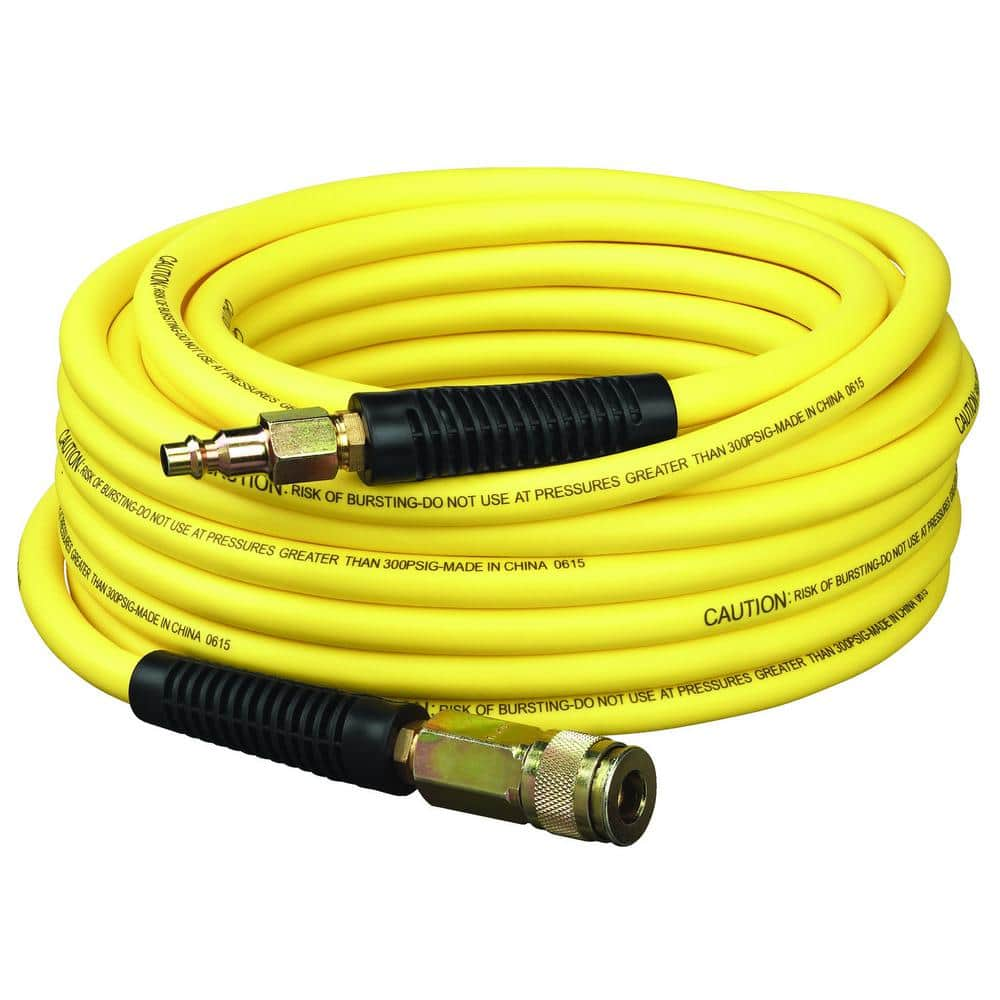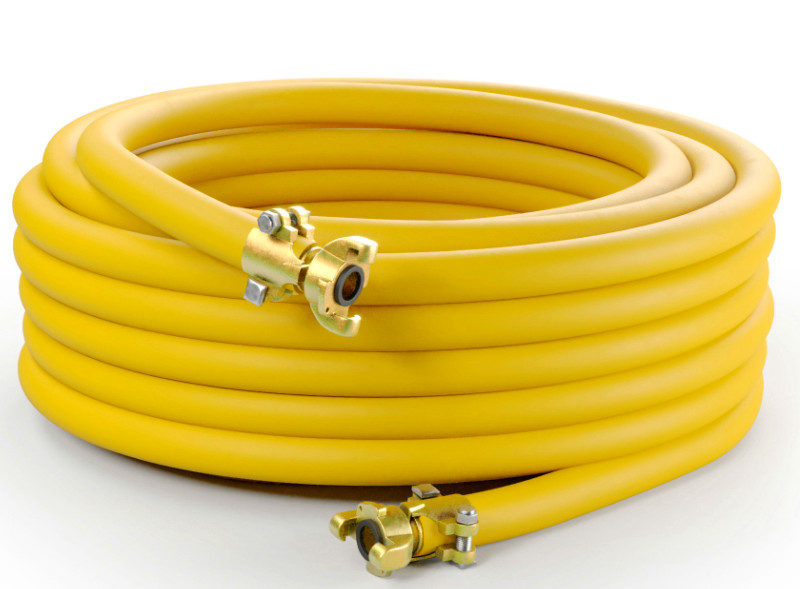If you use an air compressor, you know how important the right air hose is. The right compressor air hose can make your work smoother, faster, and safer.
But with so many options out there, how do you pick the best one for your needs? You’ll discover what makes a great air hose, how to choose the perfect fit for your tools, and tips to keep it lasting longer.
Keep reading—your next project will thank you.

Credit: www.amazon.com
Types Of Compressor Air Hoses
Compressor air hoses come in different types. Each type serves a specific purpose. Choosing the right hose affects your work’s efficiency and safety. Below are common types used in many workshops and industries.
Pvc Hoses
PVC hoses are lightweight and flexible. They resist kinks and are easy to handle. These hoses work well for low-pressure tasks. They offer good chemical resistance. PVC hoses are affordable and great for general use.
Rubber Hoses
Rubber hoses are strong and durable. They handle higher pressures than PVC hoses. These hoses can resist heat and rough surfaces. They are heavier but last longer. Rubber hoses are ideal for tough jobs.
Hybrid Hoses
Hybrid hoses combine features of PVC and rubber. They stay flexible but are more durable than PVC. These hoses resist abrasion and weather well. Hybrid hoses suit many different work conditions.
Polyurethane Hoses
Polyurethane hoses are very light and flexible. They resist cuts and punctures easily. These hoses work well in tight spaces. Polyurethane hoses last long and maintain shape. They are perfect for delicate or precise tasks.

Credit: www.homedepot.com
Key Features To Consider
Choosing the right compressor air hose means checking several key features. These features affect how well the hose works and how long it lasts. Understanding these points helps you pick the best hose for your needs.
Length And Diameter
Length matters for reaching work areas without moving the compressor often. Too short means less freedom. Too long can reduce air pressure. Diameter affects airflow speed. A wider hose moves more air but is heavier. Choose the right size for your tools and workspace.
Pressure Rating
The hose must handle the air pressure from your compressor. Check the pressure rating marked on the hose. Using a hose with a lower rating can cause leaks or bursts. Pick one that matches or exceeds your compressor’s max pressure.
Flexibility And Weight
Flexible hoses are easier to handle and store. Stiff hoses can be hard to move and may kink. Light hoses reduce fatigue during use. Balance flexibility and weight for comfort and durability.
Temperature Resistance
Hoses face hot or cold conditions during work. A hose with good temperature resistance stays strong in heat or cold. It prevents cracking and damage. Check the temperature range the hose can handle before buying.
Material Benefits And Drawbacks
Choosing the right material for a compressor air hose affects its performance. Each material offers unique strengths and weaknesses. Understanding these helps in picking the best hose for your needs. The balance between durability, chemical resistance, abrasion resistance, and cost is crucial. Below, we explore these key factors in detail.
Durability
Durability means how long a hose lasts under use. Rubber hoses resist cracking and weather well. PVC hoses are lighter but can become brittle over time. Hybrid materials combine flexibility with toughness. A durable hose reduces replacement frequency and saves money.
Chemical Resistance
Chemical resistance shows how well a hose handles oils, fuels, and solvents. Rubber hoses handle many chemicals but struggle with some oils. PVC hoses resist certain acids and bases. Choosing the right material avoids damage and leaks caused by chemical exposure.
Abrasion Resistance
Abrasion resistance protects the hose from wear caused by rubbing or scraping. Rubber hoses offer high abrasion resistance. Some PVC hoses are less resistant and may wear out faster. Reinforced hoses with fabric layers improve abrasion resistance further.
Cost Factors
Cost depends on material quality and construction. Rubber hoses usually cost more but last longer. PVC hoses are cheaper but may wear out sooner. Hybrid hoses fall in the middle range. Consider long-term costs, not just the price tag.

Credit: www.somaxflex.com
Common Fittings And Connectors
Compressor air hoses need fittings and connectors to link tools and machines. These parts make sure air flows smoothly and safely. Choosing the right fitting helps avoid leaks and keeps the work steady. Here are the common types used with compressor air hoses.
Quick-connect Couplers
Quick-connect couplers join air hoses fast. They let you attach or detach tools in seconds. No need for tools or twisting. This saves time and effort on the job. They also prevent air leaks by sealing tightly when connected.
Threaded Fittings
Threaded fittings screw onto hoses and tools. They come in different sizes and thread types. These fittings offer a strong, leak-free connection. They work well for permanent or long-term setups. Tightening them with a wrench ensures a secure fit.
Swivel Connectors
Swivel connectors turn without twisting the hose. This stops the hose from kinking or tangling. They improve hose life by reducing wear and tear. Swivels make moving tools easier during work. They fit between hoses and tools or other fittings.
Maintenance Tips For Longevity
Maintaining your compressor air hose properly helps it last longer and work better. Simple care steps keep the hose flexible and safe. Regular attention prevents damage and costly replacements.
Proper Storage
Store the hose in a dry, cool place away from sunlight. Avoid sharp bends or kinks that can weaken the material. Use a hose reel or hang it loosely to keep its shape. Keep it off rough surfaces to prevent abrasion.
Regular Inspection
Check the hose before every use. Look for cracks, leaks, or worn spots. Replace the hose if you find any damage. Test the fittings for tightness and air leaks. Early detection stops bigger problems later.
Cleaning Techniques
Clean the hose with a damp cloth to remove dirt and dust. Avoid harsh chemicals that can damage the hose material. Let it dry completely before storing. Keep the inside free of moisture to prevent mold and rust.
Choosing The Right Hose For Your Needs
Selecting the right compressor air hose is key for good work results. The hose must fit your tasks and tools perfectly. Using the wrong hose can cause leaks, low pressure, or tool damage.
Think about how you plan to use the hose. Different jobs need different hose types. Size, length, and material all affect hose performance.
Home Use Vs. Industrial Use
Home use hoses are usually lighter and shorter. They handle lower pressure and less frequent work. Industrial hoses are stronger and longer. They withstand higher pressure and tough conditions.
Choose a hose based on how often and hard you will work. For small home projects, a simple hose works well. For heavy jobs, pick a durable industrial hose.
Compatibility With Tools
Check the hose fittings match your tools. Many tools use standard connectors, but some need special fittings. The hose diameter must fit the tool’s air inlet. Wrong size means air loss or no fit.
Look at the tool manual for hose size and connector type. This ensures smooth operation and prevents damage.
Budget Considerations
Hoses come in many price ranges. Cheap hoses may save money but wear out fast. Expensive hoses offer better quality and last longer. Think about how much you will use the hose.
Spend wisely. A good hose for your needs saves money over time. Avoid buying too cheap or too costly without reason.
Frequently Asked Questions
What Is A Compressor Air Hose Used For?
A compressor air hose connects air compressors to tools or devices. It delivers pressurized air for various applications. It is essential for powering pneumatic tools and inflating tires efficiently.
How To Choose The Best Compressor Air Hose?
Choose based on length, diameter, and material. Consider flexibility, pressure rating, and durability. A high-quality hose ensures safety and optimal air flow for your tasks.
Can Compressor Air Hoses Handle High Pressure?
Yes, most compressor air hoses are designed to handle high pressure. Check the hose’s PSI rating to match your compressor’s output. Using the correct hose prevents leaks and accidents.
How To Maintain A Compressor Air Hose Properly?
Store it in a cool, dry place away from direct sunlight. Avoid kinks and sharp bends. Regularly check for cracks or leaks to extend its lifespan and performance.
Conclusion
Choosing the right compressor air hose makes your work easier and safer. A good hose lasts longer and handles pressure well. It helps keep your tools running smoothly every day. Pay attention to length, material, and size when buying. Proper care and storage extend hose life too.
Simple steps save money and avoid problems later. Use the right hose for your needs and enjoy better results. A small choice can make a big difference in your projects.

